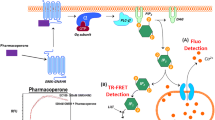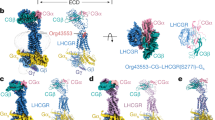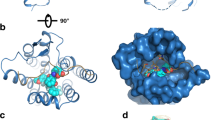Abstract
Chimeric analogs derived from pairs of homologous proteins routinely exhibit activities found in one or both parents. We describe chimeras of two glycoprotein hormones, human chorionic gonadotropin (hCG) and human follitropin (hFSH), that exhibit activity unique to a third family member, human thy-rotropin (hTSH). The results show that biological activity can be separated from hormone-specific amino acid residues. This is consistent with a model for the evolution of homologous ligand–receptor pairs involving gene duplication and the creation of inhibitory determinants that restrict binding. Disruption of these determinants can unmask activities characteristic of other members of a protein family. Combining portions of two ligands to create analogs with properties of a third family member can facilitate identifying key determinants of protein–protein interaction and may be a useful strategy for creating novel therapeutics. In the case of the glycoprotein hormones, this showed that two different hormone regions (i.e., the seat-belt and the intersubunit groove) appear to limit inappropriate contacts with receptors for other members of this family. These observations also have important caveats for chimera-based protein design because an unexpected gain of function may limit the therapeutic usefulness of some chimeras.
This is a preview of subscription content, access via your institution
Access options
Subscribe to this journal
Receive 12 print issues and online access
$209.00 per year
only $17.42 per issue
Buy this article
- Purchase on Springer Link
- Instant access to full article PDF
Prices may be subject to local taxes which are calculated during checkout
Similar content being viewed by others
References
Pierce, J.G. and Parsons, T.F. . 1981. Glycoprotein hormones: structure and function.Ann. Rev. Biochem. 50: 465–495.
McFarland, K.C., Sprengel, R., Phillips, H.S., Kohler, M., Rosemblit, N., Nikolics, K. et al. 1989. Lutropin-choriogonadotropin receptor: an unusual member of the G protein-coupled receptor family. cience 245: 494–499.
Sprengel, R., Braun, T., Nikolics, K., Segaloff, D.L. and Seeburg, P.M. . 1990. The testicular receptor for follicle stimulating hormone: structure and functional expression of cloned cDNA. Mol. Endocrinol. 4: 525–530.
Nagayama, Y., Kaufman, K.D., Seto, P. and Rapoport, B. 1989. Molecular cloning sequence and functional expression of the cDNA for the human thyrotropin receptor. Biochem. Biophys. Res. Commun. 165: 1184–1190.
Lapthorn, A.J., Harris, D.C., Littlejohn, A., Lustbader, J.W., Canfield, R.E., Machin, K.J. et al. 1994. Crystal structure of human chorionic gonado-tropin. Nature 369: 455–461.
Wu, H., Lustbader, J.W., Liu, Y., Canfield, R.E. and Hendrickson, W.A. . 1994. Structure of human chorionic gonadotropin at 2.6 Å resolution from MAD analysis of the selenomethionyl protein. Structure 2: 545–558.
Cheng, K.W., Glazer, A.M. and Pierce, J.G. . 1973. The effects of modification of the COOH-terminal regions of bovine thyrotropin and its subunits. J. Biol. Chem. 248: 7930–7937.
Merz, W.E. and Dorner, M. .1985. Studies on structure-function relationships of human choriogonadotropins with C-terminally shortened α-sub-units I. Receptor binding and immunologic properties. Biochim. Biophys. Acta. 844 62–66.
Matzuk, M.M., Keene, J.L. and Boime, I. .1989. Site specificity of the chorionic gonadotropin N-linked oligosaccharides in signal transduction. J. Biol. Chem. 264: 2409–2414.
Ward, D.N. and Moore, W.T. . 1979. pp. 151–164 in Animal models for research on contraception and fertility. Alexander, N.J. (ed). Harper and Row, New York.
Campbell, R.K., Dean Emig, D.M. and Moyle, W.R. . 1991. Conversion of human choriogonadotropin into a follitropin by protein engineering. Proc. Natl. Acad. Sci. USA 88: 760–764.
Moyle, W.R., Campbell, R.K., Myers, R.V., Bernard, M.P., .1994. Co-evolution of ligand-receptor pairs. Nature 368: 251–255.
Dias, J.A., Zhang Y, and Liu, X. 1994. Receptor binding and functional properties of chimeric human follitropin prepared by an exchange between a small hydrophilic intercysteine loop of human follitropin and human lutropin. J. Biol. Chem. 269: 25289–25294.
Tomer Y, Huber, G.K., and Davies, T.F. 1992. Human chorionic gonadotropin (hCG) interacts directly with recombinant human TSH receptors. J. Clin. Endocrinol. Metab. 74: 1477–1479.
Yoshimura, M., Pekary, A.E., Pang, X.P., Berg, L., Cole, L.A., Kardana, A. and Hershman, J.M. . 1994. Effect of peptide nicking in the human chorionic gonadotropin beta-subunit on stimulation of recombinant human thyroid-stimulating hormone receptors. European J. Endocrinol. 13092–96.
Hoermann, R., Keutmann, H.T. and Amir, S.M. 1991. Carbohydrate modifications transform human chorionic gonadotropin into a potent stimulator of adenosine 3′,5′-monophosphate and growth responses in FRTL-5 thyroid cells. Endocrinology 128: 1129–1135.
Carayon, P., Amr, S., Nisula, B. and Lissitzky, S. .1981. Effect of car-boxypeptidase digestion of the human choriogonadotropin molecule on its thyrotropic activity. Endocrinology 108: 1891–1898.
Yoshimura, M., Nishikawa, M., Yoshikawa, N., Horimoto, M., Toyoda, N., Sawaragi, I. and Inada, M. .1991. Mechanism of thyroid stimulation by human chorionic gonadotropin in sera of normal pregnant women. Acta. Endocrinol. (Copenh). 124: 173–178.
Yoshikawa, N., Nishikawa, M., Horimoto, M., Yoshimura, M., Toyoda, N. and Inada, M. .1990. Human chorionic gonadotropin promotes thyroid growth via thyrotropin receptors in FRTL-5 cells. Endocrinol. Jpn. 37: 639–648.
Pekary, A.E., Jackson, I.M., Goodwin, T.M., Pang, X.P., Hein, M.D. and Hershman, J.M. . 1993. Increased in vitro thyrotropic activity of partially sialated human chorionic gonadotropin extracted from hydatidiform moles of patients with hyperthyroidism. J. Clin. Endocrinol. Metab. 7670–74.
Glinoer, D., De Nayer, P., Robyn, C., Lejeune, B., Kinthaert, J. and Meuris, S. .1993. Serum levels of intact human chorionic gonadotropin (HCG) and its free a and B subunits, in relation to maternal thyroid stimulation during normal pregnancy. J. Endocrinol. Invest. 16: 881–888.
Tsuruta, E., Tada, H., Tamaki, H., Kashiwai, T., Asahi, K., Takeoka, K. et al. 1995. Pathogenic role of asialo human chorionic gonadotropin in gestational thyrotoxicosis. J. Clin. Endocrinol. Metab. 80: 350–355.
Yamazaki, K., Sato, K., Shizume, K., Kanaji, Y., Ito Y, Obara, T., et al.1995. Potent thyrotropic activity of human chorionic gonadotropin variants in terms of 125I incorporation and de novo synthesized thyroid hormone release in human thyroid follicles. J. Clin. Endocrinol. Metab. 80: 473–479.
Han Y, Bernard, M.P., and Moyle, W.R . 1996. hCG- Residues 94-96 alter LH activity without appearing to make key receptor contacts. Mol. Cell. Endocrinol. 124: 151–161.
Moyle, W.R., Matzuk, M.M., Campbell, R.K., Cogliani, E., Dean Emig, D.M., Krichevsky, A. et al. 1990. Localization of residues that confer antibody binding specificity using human chorionic gonadotropin/luteinizing hormone beta subunit chimeras and mutants. J. Biol. Chem. 265: 8511–8518.
Cosowsky, L., Rao, S.N.V., Macdonald, G.J., Papkoff, H., Campbell, R.K. and Moyle, W.R. . 1995. The groove between the α- and β-subunits of hormones with lutropin (LH) activity appears to contact the LH receptor and its conformation is changed during hormone binding. J. Biol. Chem. 270: 20011–20019.
Moyle, W.R., Campbell, R.K., Rao, S.N.V., Ayad, N.G., Bernard, M.P., Han Y, and Wang, Y . 1995. Model of human chorionic gonadotropin (hCG) and lutropin receptor (LHR) interaction that explains signal transduction of the glycoprotein hormones. J. Biol. Chem. 270: 20020–20031.
Strickland, T.W. and Puett, D. .1981. Contribution of subunits to the function of luteinizing hormone/human chorionic gonadotropin recombinants. Endocrinology 109: 1933–1942.
El Deiry, S., Chen, T.M. and Puett, D. .1991. Comparison of steroidogenic potencies of homologous and heterologous gonadotropins in rat and mouse Leydig cells. Mol. Cell. Endocrinol. 76: 105–113.
Yeas, M. .1974. On earlier states of the biochemical system.J. Theor. Biol. 44: 145–160.
Lewis, P.E. . 1951. Pseudoallelism and gene evolution.Cold Spring Harbor Symp. Quant. Biol. 16: 159–174.
Jensen, R.A. . 1976. Enzyme recruitment in evolution of new function. Annu. Rev. Microbiol. 30: 409–425.
Ohno, S. .1970. pp. 59–65 in Evolution by gene duplication. Springer-Verlag, New York.
Combarnous, Y. and Hengé, M.-H. . 1981. Equine follicle-stimulating hormone: purification, acid dissociation, and binding to equine testicular tissue. J. Biol. Chem. 256: 9567–9572.
Tian Y, Wu, L.-H., Oxender, D.L., and Chung, F.-Z. 1996. The unpredicted high affinities of a large number of naturally occurring tachykinins for chimeric NK1/NK3 receptors suggest a role for an inhibitory domain in determining receptor specificity. J. Biol. Chem. 271: 20250–20257.
Marengere, L.E.M., Songyang, Z., Gish, G.D., Schaller, M.D., Parsons, J.T., Stern, M.J. et al. 1994. SH2 domain specificity and activity modified by a single residue. Nature 369: 50.
Souza, S.C., Frick, G.P., Wang, X., Kopchick, J.J., Lobo, R.B. and Goodman, H.M. . 1995. A single arginine residue determines species specificity of the human growth hormone receptor. Proc. Natl. Acad. Sci. USA 92: 959–963.
van de Poll, M.L.M., Lenferink, A.E.G., van Vugt, M.J.H., Jacobs, J.L.J., Hanssen, J.W.H., Joldersma, M., and van Zoelen, E.J.J. 1995. A single amino acid exchange, Arg-45 to Ala, generates an epidermal growth factor (EGF) mutant with high affinity for the chicken EGF receptor. J. Biol. Chem. 270: 22337–22343.
Lee, C.-H., Leung, B., Lemmon, M.A., Zheng, J., Cowburn, D., Kuriyan, J. and Saksela, K. .1996. A single amino acid in the SH3 domain of Hck determines its high affinity and specificity in binding to HIV-Nef protein.EMBO J. 14: 5006–5015.
Turner, P.R., Bambino, T. and Nissenson, R.A. . 1996. A putative selectivity filter in the G-protein-coupled receptors for parathyroid hormone and secretin. J. Biol. Chem. 271: 9205–9208.
Cole, E.S., Lee, K., Lauziere, K., Kelton, C.A., Chappel, S.C., Weintraub, B.D. et al. 1993. Recombinant human thyroid stimulating hormone: development of a biotechnology product for detection of metastatic lesions of thyroid carcinoma. Bio/Technology 11: 1015–1024.
Pavlakis, G.N., Felber, B.K., Wright, C.M., Papamatheakis, J. and Tse, T. .1987. pp. 29–38 in Gene transfer vectors for mammalian cells. Miller, J.H. and Calos, M.P. (eds). Cold Spring Harbor Press, New York.
Wang Y, Han, Y, Myers, R.V., Macdonald, G.J., and Moyle, W.R. 1994. pp. 191–196 in Ovulation induction: basic science and clinical advances. Filicori, M. and Flamigni, C. (eds). Excerpta. Medica. Int′l. Congr. Series 1046, Elsevier Science B.V., Amsterdam.
Moyle, W.R., Ehrlich, P.H. and Canfield, R.E. . 1982. Use of monoclonal antibodies to hCG subunits to examine the orientation of hCG in the hormone-receptor complex. Proc. Natl. Acad. Sci. USA 79: 2245–2249.
Morris, J.C., Jiang, N.S., Charlesworth, M.C., McCormick, D.J. and Ryan, R.J. . 1988. The effects of synthetic alpha-subunit peptides on thyrotropin interaction with its receptor.Endocrinology 123: 456–462.
Morris, J.C., McCormick, D.J. and Ryan, R.J. . 1990. Inhibition of thyrotropin binding to receptor by synthetic human thyrotropin beta peptides. J. Biol. Chem. 265: 1881–1884.
Vitti, P., Elisie, R., Tonacchera, M., Chiovato, L., Mancusi, F., et al.1993. Detection of thyroid-stimulating antibody using Chinese hamster ovary cells transfected with cloned human thyrotropin receptor. J. Clin. Endocrinol. Metab. 76: 499–503.
Vitti, P., Rotella, C.M., Valente, W.A., Cohen, J., Aloj, S.M., Laccetti, P. et al. 1983. Characterization of the optimal stimulatory effects of Graves' monoclonal and serum immunoglobulin G on adenosine 3′,5′-monophosphate production in FRTL-5 thyroid cells: a potential clinical assay. J. Clin. Endocrinol. Metab. 57: 782–791.
Brooker, J., Harper, J.F., Terasaki, W.L. and Moylan, R.D. . 1979. Radio-immunoassay of cyclic AMP and cyclic GMP. Adv. Cyclic Nucl. Res. 10: 1–33.
Author information
Authors and Affiliations
Rights and permissions
About this article
Cite this article
Campbell, R., Bergert, E., Wang, Y. et al. Chimeric proteins can exceed the sum of their parts: Implications for evolution and protein design. Nat Biotechnol 15, 439–443 (1997). https://doi.org/10.1038/nbt0597-439
Received:
Accepted:
Issue Date:
DOI: https://doi.org/10.1038/nbt0597-439
This article is cited by
-
Exploring protein fitness landscapes by directed evolution
Nature Reviews Molecular Cell Biology (2009)



